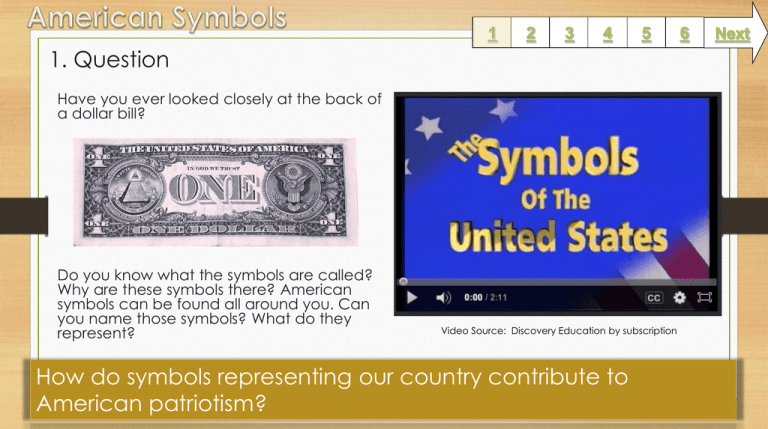
1
2
3
4
5
1. Question
Have you ever looked closely at the back of
a dollar bill?
Do you know what the symbols are called?
Why are these symbols there? American
symbols can be found all around you. Can
you name those symbols? What do they
represent?
Video Source: Discovery Education by subscription
How do symbols representing our country contribute to
American patriotism?
6
Next
2. Information Sources
1
Click on the icon.
2
3
4
5
6
The Liberty Bell
Discover the meaning behind these U.S. Symbols.
Liberty Bell
U.S. Capitol
Jefferson Monument
Great Seal
Washington
Monument
Star Spangled
Banner
The U.S. Capitol
Watch this video on the Great Seal!
Image Sources: Pebblego.com by subscription
I can do on my own.
Challenge me!
Image Sources: Pebblego.com by subscription
Video Source: Discovery Education
Next
3. Student Activity
1
2
3
4
5
6
Using the American Symbols
and Monuments Note Taker,
identify the symbol and
monument, explain what it
stands for, and draw what it
looks like.
You need to choose 4 symbols
or monuments and complete
the organizer.
Source: Cassie Smith from Teachers Pay Teachers
Next
1
2
3
4
5
6
4. Assessment Activity
After you have researched four American Symbols, choose one symbol or
monument that interested you the most.
Complete this organizer which will help you complete your final assessment.
You can choose any of the three tools listed below to create it. Use this rubric to
help you!
Create using Wixie.
Image Source: Wixie.com
Create using Tagxedo.
Create using the Printing Press.
Image Source: readwritethink.org
Next
1
5. Enrichment Activities
2
3
4
5
6
Next
Learn more about
American symbols with this
interactive poster.
Listen to Anna’s adventure on TumbleBooks!
Can you guess the American symbol?
Click the speaker to try it out.
Audio Source: Discovery Education by subscription
Image Source: Discovery Education by subscription
6. Teacher Support Materials
Grade Level and Content Area
BCPS Curriculum / Maryland State Curriculum
Grade 2: Library Media Curriculum
Common Core State Standards
RI.2.1. Read closely to determine what the text says explicitly and to make logical inferences from it; cite specific textual evidence when
writing or speaking to support conclusions drawn from the text.
RI.2.2. Determine central ideas or themes of a text and analyze their development; summarize the key supporting details and ideas.
SL.2.1. Participate in collaborative conversations with diverse partners about grade 2 topics and texts with peers and adults in small and
larger groups.
Writing: 7. Conduct short as well as more sustained research projects based on focused questions, demonstrating understanding of the
subject under investigation.
1
2
3
4
5
6
Time Frame: Three 50 minute lessons
Differentiation strategies for this lesson:
• Certain resources can have the text read to students.
• Students can work in groups for this lesson.
• Silver stars mean on grade level resources and gold
stars mean the resources are more challenging.
Learning Styles addressed in this lesson:
Auditory, Visual, Kinesthetic, Reflective, Sequential,
Field Independent
Maryland State Standards Social Studies:
Standard 1.0- Political Science :Topic A. The foundations and function of the government: 2. Explain how democratic skills and attitude
are associated with being responsible: b. Connect certain people, symbols, songs and poems to the ideals they represent, such as George
Washington portrays leadership, the American flag represents loyalty and respect, and the Star Spangled Banner represents courage and
freedom.
21st
Standards for the
Century Learner
1.1.6 Read, view, and listen for information presented in any format (e.g. textual, visual, media, digital) in order to make inferences and
gather meaning.
2.1.3 Use strategies to draw conclusions from information and apply knowledge to curricular areas, real-world situations, and further
investigations.
ISTE NETS - National Educational Technology Standards for Students
3. Research and Information Fluency: Students apply digital tools to gather, evaluate, and use information.
b. Locate, organize, analyze, evaluate, synthesize, and ethically use information from a variety of sources and media.
Notes to the teacher:
•Only to be used in the Library Media curriculum.
•Students may have to login in to Discovery Education and
TumbleBooks because of issues with direct linking.
•Students will need headphones to view resources.
•LMS will need to print and make copies of organizers for
students to use.
•Students may need to log in to TumbleBooks and search for
the story.
4. Critical Thinking, Problem Solving, and Decision Making: Students use critical thinking skills to plan and conduct research, manage
projects, solve problems, and make informed decisions using appropriate digital tools and resources. c. Collect and analyze data to
identify solutions and/or make informed decisions.
Last updated: July 2015 Created by Marlena Aumen, Library Media Specialist Intern
BCPS Slam Dunk Research Model, Copyright 2013, Baltimore County Public Schools, MD, all rights reserved. The models may be used for educational, non-profit school use only.
All other uses, transmissions, and duplications are prohibited unless permission is granted expressly. This lesson is based on Jamie McKenzie’s Slam Dunk Lesson module.

